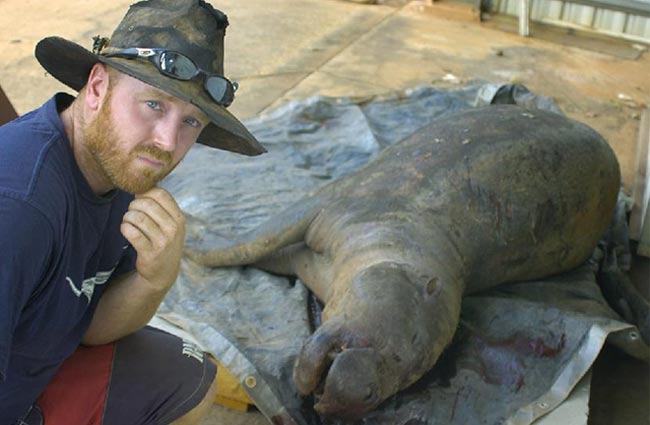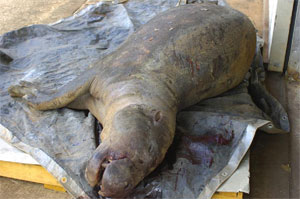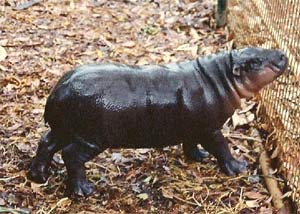Cryptid Pygmy Hippo Shot in Oz
Posted by: Loren Coleman on November 17th, 2009
Australia is called Oz. Now news is breaking that the cryptozoologically significant species, the pygmy hippopotamus, only found in Liberia and Nigeria, in Africa, has turned up in Oz.
The animal escapee theory here may be correct in this case. Nevertheless, as one of those involved said: “You don’t expect to see a hippo in the Australian bush.”
It may be the most bizarre escapee to have survived for sometime in the wild, in this case supposedly five years, if this notion is spot on.
Pygmy hippo shot in NT
Northern Territory News
Article by Alyssa Betts
November 16th, 2009

The pygmy hippo that was accidentally shot. Picture: Katrina Bridgeford
A pygmy hippopotamus has been shot dead during a pig hunting expedition in the Territory.
The hippo is normally native to the swamps of west Africa, in particular Liberia.
Instead, this one – estimated to be about 250kg – was shot while roaming the bush of the Douglas Daly, 200km south of Darwin.
This is about 16,000km away from Liberia.
It is believed the female hippo is an old escapee from Tipperary Station, from when it used to be an exotic animal reserve.
This means it has been poking about the Douglas Daly for the past five years.
Nico Courtney, 27, was out spotlighting for pigs with his mate Rusty on a station in the Douglas Daly district on Saturday night.
“It was about 1am and running away from us – from the tail end it just looked like a big pig,” the station worker said.
“We got out, had a look at it, and thought ‘that’s not a pig, it’s a hippo’.
“Then we thought ‘you don’t get hippos in Australia’.”
The pair thought it might be a baby hippo – and then naturally started wondering, as they stood in the middle of dark scrub, “where the hell” its mum and dad might be.
Mr Courtney said he rang a few mates to tell them what happened.
“They told me to go to bed,” he said. “So I thought I’d better call the boss, and he said ‘no it couldn’t be’.”
They both decided to get some shuteye and “reassess the situation in the morning”.
But it was still a hippo come daylight.
Mr Courtney’s boss, Gordon Coward, reckons the hoofer is from Tipperary Station.
“I heard all sorts of funny stories of break outs and people kept saying ‘look out for giraffes in the paddock’, but I didn’t think much of them.”
Tipperary Station – which is about 50km from Douglas Daly – was turned into an exotic wildlife sanctuary by its former owner, millionaire Warren Anderson.
Mr Anderson eventually began trying to sell the animals – which included rhinoceroses, hippopotamuses, giraffes, zebras and deer – back in 2003 after selling his interest in the station.
But some of the planned transfers were caught up in a legal wrangle between the Territory Government and Mr Anderson.
The hippo’s carcass is now being kept in a cold room at the Douglas Daly Research Farm.

vvvvvvvvvvvvvvvvvvvvvvvvvvvvvvvvvvvvvvvvvvvv

Kumbe – thought to be the brother of the pygmy hippo shot at Douglas Daly on the weekend – was one of four pygmy hippos moved to Tipperary Station from the Pearl Coast Zoo at Broome in 1991.
Pygmy hippo could be tip of iceberg
The Northern Territory News, Darwin, Australia
Article by Matt Cunningham and Annie Sanson
November 17, 2009
Strange animal sightings have been commonplace in the area where a pygmy hippopotamus was shot on the weekend, locals said yesterday.
Douglas Daly residents say they have seen strange animals wandering around for years.
“We drove past there once and saw a couple of deer and about 500m away there was a thing – too big for a pig,” one resident said.
“We thought it must have been a baby buffalo that looked a bit strange, but looking back now it easily could have been the hippo, as that’s how the thing looked like – but you don’t expect to see a hippo in the Australian bush, so we didn’t worry about the ‘little weird looking buffalo’ too much.”
Nico Courtney accidentally shot the pygmy hippo after mistaking it for a wild pig while out hunting on Saturday night.
The hippo is believed to have escaped from the Tipperary Station Wildlife Sanctuary – then owned by multi-millionaire Warren Anderson – after it was closed in 2003.
Most of the animals were moved to a zoo in Queensland, but at least one was left behind.
The station’s former curator of operations Kevin Langham left the sanctuary three years before operations were wound up.
He said he was shocked the hippo had been left behind.
“It’s rather strange that they would have left it behind,” he said.
“The area they were kept in was quite small and the (hippos) were very territorial. Even it it had escaped it wouldn’t have gone very far and wouldn’t have been a very difficult animal to capture.
“The other interesting thing is, if they are out there, what else is out there?”
Former zookeeper Christine Baker said she believed the hippo was one of four that were brought to Tipperary Station from the Pearl Coast Zoo at Broome in 1991.
She said there was a breeding pair and two juveniles bought to Tipperary after the WA zoo closed down.
“This is probably the daughter, who would be 18,” she said. “I had no idea that any of the stock at Tipperary had escaped.”
But former Tipperary Station manager David Warriner, who took over after the sanctuary closed, said it was well known that a hippo had escaped. “It’s been there for years obviously,” he said.
“It escaped out of the zoo while they were shifting all the animals.
“It was just assumed that it had died, but there was one missing when they shifted all the animals.”
Mr Anderson could not be contacted yesterday.
About Loren Coleman
Loren Coleman is one of the world’s leading cryptozoologists, some say “the” leading living cryptozoologist. Certainly, he is acknowledged as the current living American researcher and writer who has most popularized cryptozoology in the late 20th and early 21st centuries.
Starting his fieldwork and investigations in 1960, after traveling and trekking extensively in pursuit of cryptozoological mysteries, Coleman began writing to share his experiences in 1969. An honorary member of Ivan T. Sanderson’s Society for the Investigation of the Unexplained in the 1970s, Coleman has been bestowed with similar honorary memberships of the North Idaho College Cryptozoology Club in 1983, and in subsequent years, that of the British Columbia Scientific Cryptozoology Club, CryptoSafari International, and other international organizations. He was also a Life Member and Benefactor of the International Society of Cryptozoology (now-defunct).
Loren Coleman’s daily blog, as a member of the Cryptomundo Team, served as an ongoing avenue of communication for the ever-growing body of cryptozoo news from 2005 through 2013. He returned as an infrequent contributor beginning Halloween week of 2015.
Coleman is the founder in 2003, and current director of the International Cryptozoology Museum in Portland, Maine.










The climate around the Douglas Daly station is hot, humid, and tropical from what I understand which makes it similar to the conditions that pygmy hippos are used to. Pygmy hippos are not particularly choosy about what they eat, they eat a wide variety of plants, and will eat pretty much whatever vegetation or fruit is available. The Douglas Daly experiment station is also located at the junction of the Douglas and Daly rivers, which combined with the climate would make the habitat perfect for a largely river dwelling tropical animal like the pygmy hippo.
If there were adequate food resources in this area, and the hippo was in good health, then I suppose it is not too far fetched that it could survive on its own for five years.
I’m not too surprised. In my research concerning introduced and invasive species in foreign ecosystems, one thing I’ve learned is that people tend to sometimes underestimate how tenacious and adaptable some animals can be. In a habitat seemingly so nearly approximating the pygmy hippo’s native environment, with an opportunistic feeder like this hippo is known to be, I don’t see any reason why it should have been assumed dead after its escape.
ya know that probably hasn’t helped the whole “its an escaped pet/circus train/zoo animal”.
ps: kind of having to do with this, are there even any circus trains that could be explanations for such creatures as bigfoot and nessie?
I know that the feral hog problems can be very destructive to farms and ranches. And that going around in the middle of the night with rifles looking for SOMETHING to kill can be very exciting to a certain group of REAL MEN of the outback. If the bush was so thick that they could not identify what they were trying to kill, it was not really habitat that would be hurt by 1 hippo. They should have been more knowlegdeable about what they were firing at and trying to kill. Hope these type of guys are not out trying to “hunt” the wowies and fire at something that sort of looks like a dark hairy human-like animal at night, that turns out to be another human. But again they are getting their 15+ minutes of fame, and probably a lot of free Foster’s.
In response to gkingdano’s comment, although the report Loren has referred to doesn’t reflect it, other media reports indicate that the hunters were quite distressed when they realised the animal was a pygmy hippo:
“The manager of a cattle station in the Douglas Daly region south-west of Darwin says he feels devastated and horrified to have shot a pygmy hippopotamus on Saturday night…Nico says he feels sick in the stomach after accidentally slaughtering the rare species…I am a bit disgusted, sick to my stomach. It is on the way to get taxidermied, to get it all put together so people can see it. It is not really a trophy or something you would brag about. It makes you feel sick.”
From the Australian Broadcasting Corporation website
This is one of those “You don’t say” moments. Wonder what other African species are out there in Good Ole Down Under???
I agree with you, Mystery_Man. I’m also not surprised this Pygmy Hippo survived for five years in this habitat. Tropical humid weather is common in OZ. More to come, I guess. 🙂
gkingdano:
Please wait until you know just a few more facts before painting hunters in such broad uninformed strokes. Not only has another poster pointed out that they weren’t happy to shoot the animal, but I personally don’t think it takes a kill happy individual to mistake a wild pig for a pygmy hippo. And being from Oklahoma myself I can’t say that I or anyone else I know would try to get close enough to examine a hog at night to see if it might be an out of place hippo. (1: because hogs aren’t the friendliest of animals to approach. 2: Why would anybody think there might even be a small chance of there being a hippo where one doesn’t belong!?)
Poor Hippo!!
OK Maybe I spoke to fast on the station personnel’s personal feelings. But If one goes out at night with guns and spotlights to hunt hogs, I doubt that one is just going to kiss them and let then go on unharmed. To stuff and put on show the dead hippo sure sounds like a trophy to me, just because they are not going to eat it. Next time I will wait til y’all make your comments before I put in my 2 cents, so that I can get a feel of how everyone else is going to comment and just go along with everyone else. As one who HAS hunted feral hogs at night, I know that you don’t just start shooting at something that is running away from the spotlight just so one can get a kill. If the feral hogs are doing damage to the station grounds, there are better ways to control then{baiting and daylight kill zones or traps}, but they will COST more than a box of bullets. I admit that I have not traveled to Australia and personally talked to the reporters and the station personnel on exactly the conditions of the damage and bush thickness.
PS. Saw you on Lost Tapes last night, Loren. And How fast is to fast on posting? Got a message that I was posting to fast.
gkingdano- One hippo certainly would not have caused any significant damage to the ecosystem of the area. I didn’t mean to imply that when I brought up invasive species. What I was trying to do was illustrate that animals out of their natural environment (such as invasive species) can often survive a lot better than many give them credit for. There are lots of cases of animals surviving in areas that do not even really represent the type of biome they are native to. Nature often finds a way.
As to the keeping hippo carcass, I don’t know if I’d call it a “trophy” in this case. The article says that it has been put in a cold room, which is quite ba bit different than having it stuffed and put up for show. There are a lot of reasons for them to want to preserve the carcass. I imagine that they are probably going to want to study it. There’s actually a lot of information that could be gleaned from the carcass, such as what its preferred diet was in this habitat, what it’s general health is after 5 years on its own in a foreign environment, any sorts of parasites or diseases it might have been carrying, and so on. I hardly think the reason for keeping it is to use it as a trophy.
As to the hunters’ feelings concerning the kill, it surely does seem that the hunters are distressed and regretful. Just looking at the face of the guy in the picture, the expression on his face makes him seem almost ashamed, and not happy or proud of what has transpired.
I think this was an honest mistake. Humans get accidentally shot while hunting all of the time, do they not? This was a strange animal where no one would expect it, and under the right circumstances, such as in dense brush, a pygmy hippo could certainly be mistaken for a wild boar in my opinion.
There’s no reason at all that they could have possibly expected a hippo to be there. If they had idenitified it as such, they may have done things differently, but these were not researchers. They were hunters out hunting boar and came across an animal that looks like one. Surely this unfortunate ocurrence can’t be too surprising.
It’s a shame, but I’m not sure we can really blame the hunters too much in this case.
I agree with you, Mystery_Man. Precisely what you said. 🙂